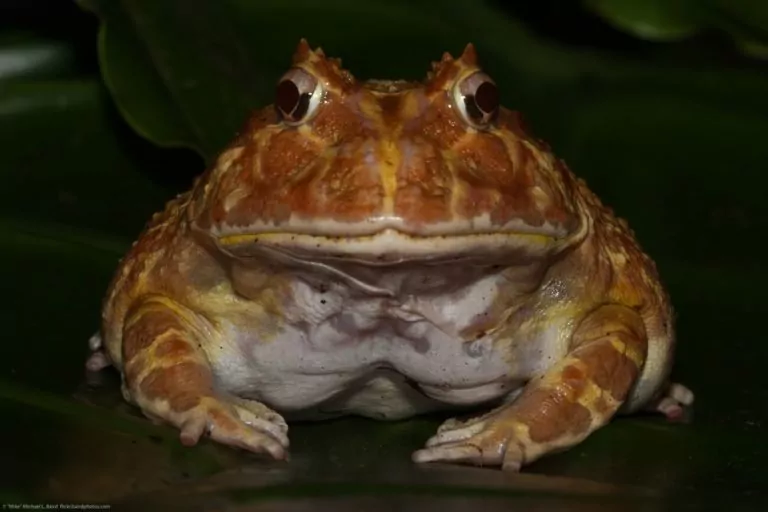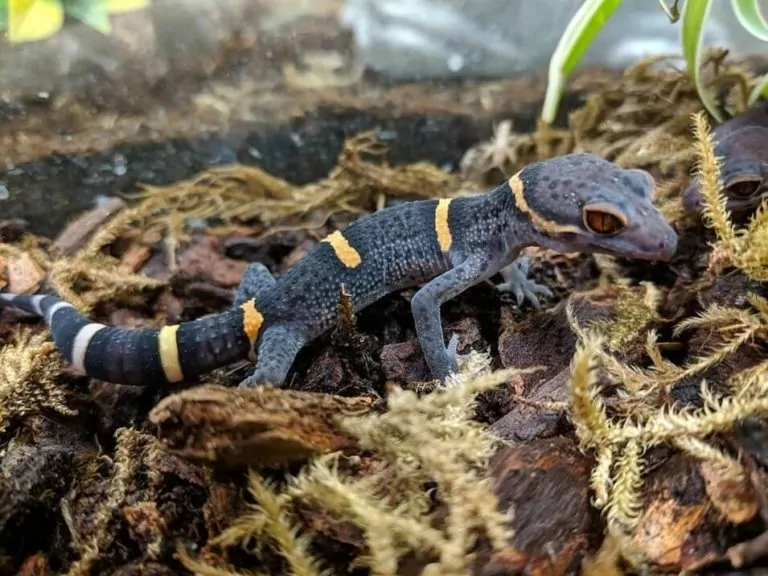Pink-bellied side-neck turtles are a beautiful pet reptile that we absolutely love! Their stunning appearance makes them a joy to own, and entertaining to spectate while they swim around the tank.
But like most primarily aquatic turtles, you need to have a strong understanding of tank and water maintenance if you want them to thrive. Their requirements aren’t always straightforward!
This guide covers everything you should know when it comes to pink-bellied side-neck turtle care. Simply stick to the recommendations below and you’ll be all set!
Table of Contents
Species Summary
The pink-bellied side-neck turtle (Emydura subglobosa) is a sweet, easy-going turtle that is native to areas of Papua New Guinea and Australia. These water lovers, also sometimes called red-bellied side-neck turtles, can be found in water habitats such as swamps, ponds and rivers.
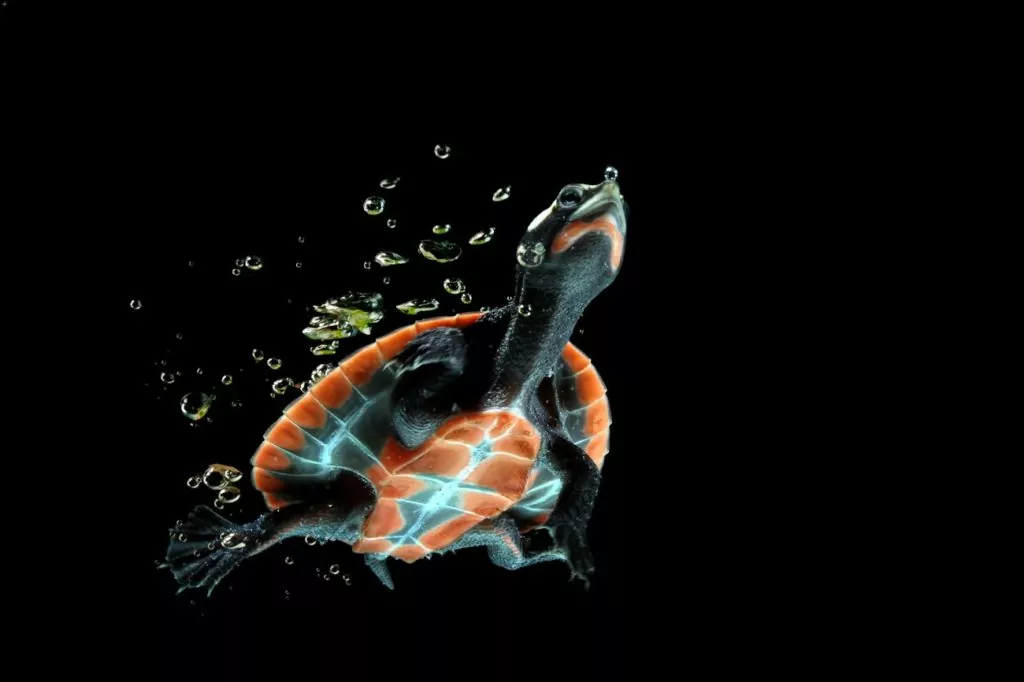
These lovely little turtles are known for their beautiful coloration and their friendly temperament. However, pink-bellied side-neck turtle care requires more than a basic knowledge if you want them to thrive. We typically suggest that only intermediate to advanced turtle owners attempt to care for this incredible pet turtle.
Appearance & Colors
The pink-bellied side-neck turtle is coveted by turtle enthusiasts the world over for their distinctive and cheerful coloration.
Their shells tend to be a rather typical turtle shade of gray, brown or beige. It’s their plastron that gives these turtles their beauty and popularity. Coloration varies from turtle to turtle, but the basic plastron colors include pink, red and even bright orange. The skin of this turtle is usually gray with two yellow stripes.
Expert Tip: Males will have longer and thicker tails than females. Besides that, there isn’t much of a difference (other than size).
Pink-Bellied Side-Neck Turtle Size
The average pink-bellied side-neck turtle size is around five inches for males, and 10 inches for females. Females can, on rare occasions, get up to 16 inches in length.
Hatchlings are usually about 1.25 inches. This leaves a lot of room for growth once you purchase them!
Lifespan
The typical pink-bellied side-neck turtle lifespan is usually between 20 and 30 years in captivity.
There have been rare situations where the combination of proper care and great genetics have led to specimens living up to 50 years. However, this is quite uncommon and challenging to replicate.
Pink-Bellied Side-Neck Turtle Care
Pink-bellied side-neck turtle care requires you to have a strong understanding of the habitat these pet reptiles need to thrive. These are primarily aquatic turtles, so the general care strategy and tank setup should be geared towards their love of water.
They are going to need a proper aquarium, clean water, a healthy diet and the right lighting system. But most of all, they are going to need their space and freedom to swim, forage, and bask.
Since turtles are not the cleanest pets, you will also need to be vigilant about cleaning the aquarium set up (more on that later). As long as you understand these requirements, you should be able to provide this species with a great life.
Tank Size & Dimensions
This side-necked turtle is not overly fussy about their enclosure as long as it’s big enough. The rule of thumb for aquarium size is to use a 20 gallon tank for turtles up to four inches in length.
As the turtle grows, you will need to add ten gallons for every extra inch. This will provide them with plenty of room to swim, dive and forage.
Expert Tip: We recommend using an all glass aquarium if possible. This will give you the ability to watch this beautiful turtle as it swims about the enclosure (the pink-bellied side-neck turtle is known to be quite active).
Tank Setup
Now that we’ve discussed the size of the tank, let’s talk about the actual setup.
When designing the interior of your aquarium, it’s advisable to always start with a good substrate.
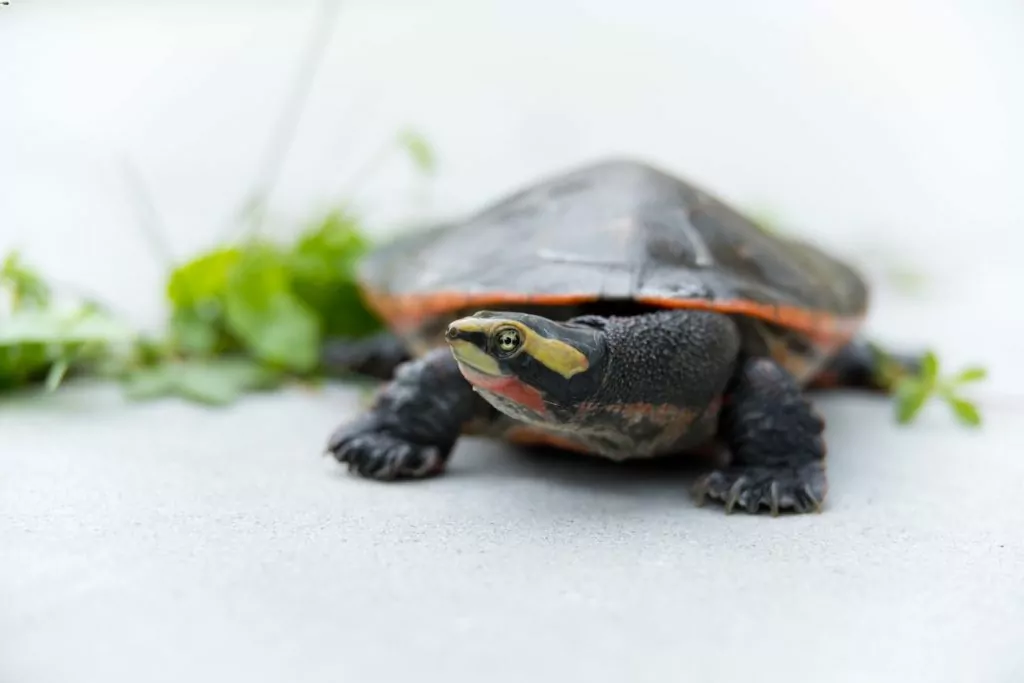
Stones larger than the turtles head are fine, and rinsed play sand is another good choice. Always rinse the sand before using as it can contain toxins and bacteria. Never use any type of gravel because your turtle can choke on the gravel pieces.
It goes without saying that your aquarium set up is going to need lots of clean water. Some turtle experts say that this kind of turtle can handle a variety of different waters, but we strongly suggest that you add a good water filter and a dechlorinator to your set up.
This next part is where you get to be really creative. Even though your pink-bellied side-necked turtle is primarily aquatic, you will need to provide places to bask and spots where they can hide. Some options are turtle safe plants (artificial or natural), different sized logs, large stones or turtle ramps.
The design is really up to you. The key is to create a living space for your turtle that will be as natural and comfortable as possible. Make sure to always design your enclosure in a way that your turtle won’t get stuck in or under any of the items you add.
Expert Tip: These turtles can be kept in an outdoor pond setting, but we recommend using an indoor setup since you can control all the variables and factors of their care.
Temperature & Lighting
Your turtle is going to need a type of gradient heating that keeps the temperature slightly warmer in the basking area.
The best temperature for your pink-bellied side-neck turtle is between 66 and 80 degrees Fahrenheit on the cool side, with the basking area needing to be in the low to mid 90’s. Using a halogen lamp is a great way to accomplish this.
Expert Tip: If you have hatchlings, they will need slightly warmer water that stays between the low 70’s to the low 80’s. Use an attachable thermometer to easily monitor the aquarium’s temperature.
If you have your pink-bellied side-neck turtle outdoors, they are going to get all the lighting they need. Indoor turtles, however, are going to require some specialized lighting.
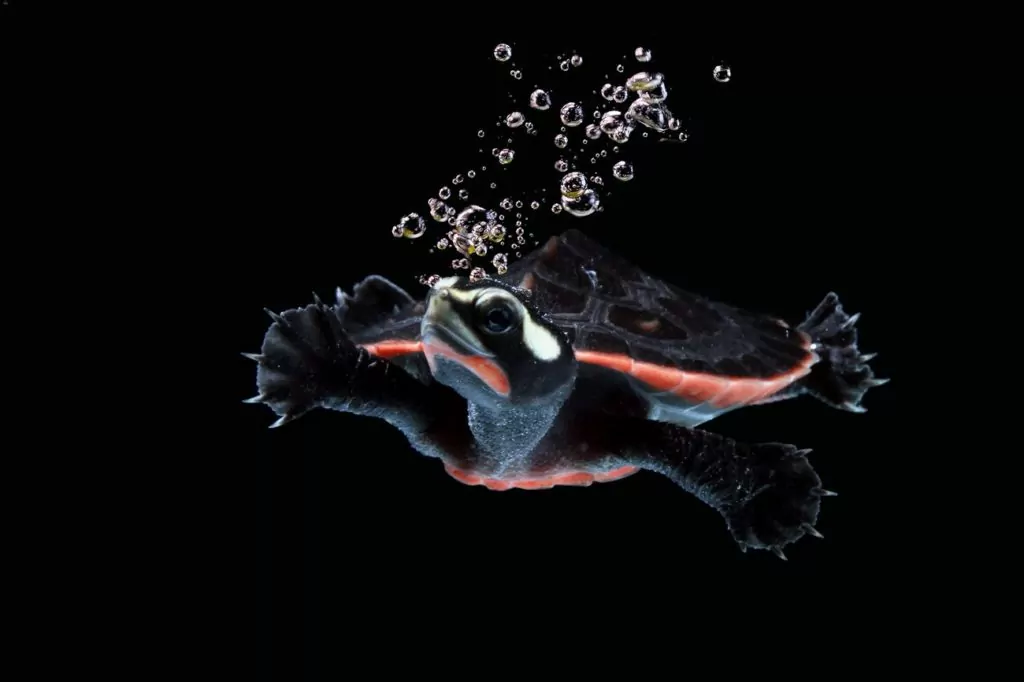
Without the correct lighting, your turtle will become susceptible to metabolic bone disease and other health issues that we will discuss later. To prevent these issues, you can use a 75 watt spotlight or some type of UVB bulb. It’s important to create a UVB cycle of 12 hours on and 12 hours off.
Between the basking lamp and the UVB bulb, your turtle will have all of the heat and lighting it requires. It is important to never put your aquarium in direct sunlight. This can cause the water in the tank to become too hot (and lead to algae growth).
Humidity
Pink-bellied side-necked turtles are mainly aquatic and don’t have specific humidity-level requirements. As long as you’re meeting their temperature requirements and keep them in an optimal tank setup, you’re all set!
Water
Maintaining clean, fresh water in your enclosure is one of the most important parts of pink-bellied side-necked turtle care. Water quality will play a critical role in the overall health and well-being of this pet.
Expert Tip: Using a high-quality dechlorinator and an effective filter will help to ensure that the water in the enclosure is fresh and free of harmful chemicals. Perform partial water changes as well to keep everything healthy and clean.
Food & Diet
This pet turtle is not overly finicky when it comes to diet. In nature, pink-bellied side-neck turtles eat things like insects, crustaceans and mollusks.
In your aquarium environment, you can give them items that help replicate their natural diet. Your turtle will enjoy foods such as bloodworms, fish, crickets, turtle pellets and vegetables. Because this type of turtle does not get any kind of nutritional benefit from shrimp, they should never be included in their diet.
You will also need to vary their diet depending on age. Here are some guidelines to follow:
- Hatchlings: You can feed them every day, and they should only be fed turtle pellets.
- Juveniles: Juveniles can be given a wider variety of foods such as pellets, crickets, worms and vegetables. You should feed them every other day.
- Adults: When these turtles are at full maturity they should be fed three to four times a week. You can give them a variety of worms, fish pieces, crickets and veggies.
In general, veggies can be given once a week and should include foods like shredded carrot and Romaine lettuce.
Always feed your turtle in the water because they enjoy swimming around and foraging for their food. This natural way to feed will keep them feeling happy and secure in their environment.
Potential Health Issues
Spotting health issues before they become serious is very important. Pink-bellied side-necked turtles, like most turtles, can suffer from a myriad of health issues (especially when not given proper care). Knowing in advance what these issues are and having a great relationship with your veterinarian will help to ensure the health and happiness of your pet.
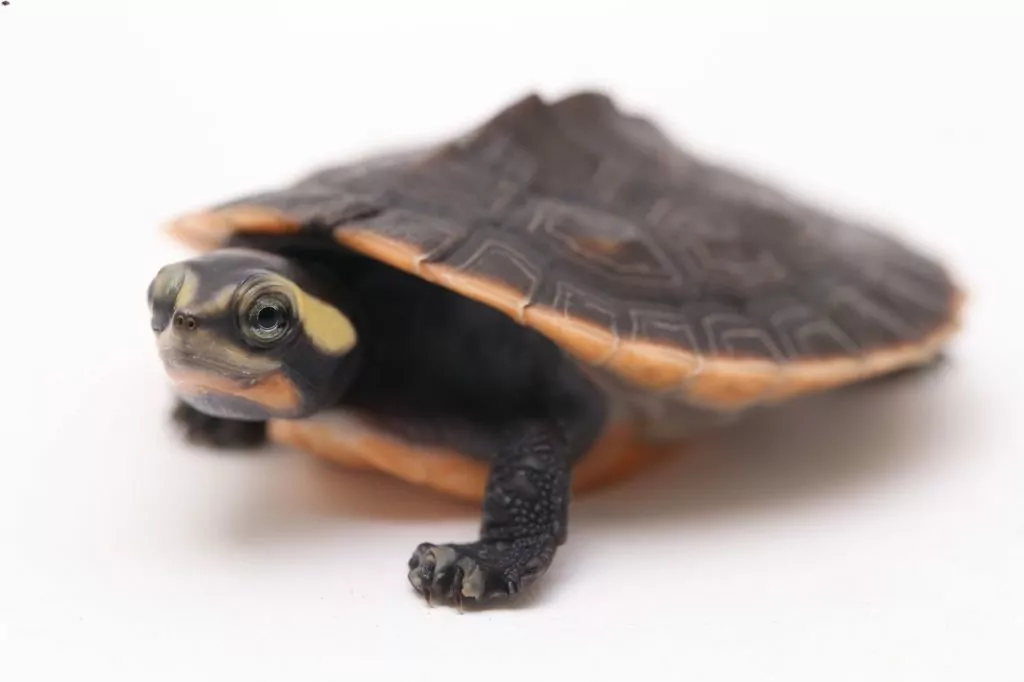
Vitamin A deficiencies: This is an preventable health issue that can cause a long list of problems. A deficiency in vitamin A comes from not having enough UVB light, and it can also stem from an unbalanced diet. Providing proper lighting and a balanced feeding program will help to prevent this dangerous issue.
Signs that your turtle may be suffering from Vitamin A deficiency include lethargy, lack of an appetite and bulging eyeballs.
Respiratory issues: These are often caused by lack of Vitamin A as well as from bacteria in the water. If you see that your turtle has no appetite, has excess mucus, is mouth breathing or is very lethargic, it could have a respiratory infection. Your turtle will need to see your vet right away for treatment.
Parasites: Pink-bellied side-neck turtles are rather prone to internal parasites such as roundworms, and your vet can do a fecal test to check for these harmful parasites. If you notice diarrhea, your turtle may have parasites.
Boils: This is a health problem that many owners aren’t prepared for, since it’s not found in many other popular pet reptiles. Boils are often caused by a Vitamin A deficiency. A boil will look like a hard tumor, and it’s filled with pus. Take your turtle to the vet immediately for specialized treatment if you see one of these anywhere on your pet.
Shell rot: Issues with the shell (such as fissures and cracks) can really plague your turtle. These problems are usually caused by bacterial or fungal infections, and these issues can lead to serious complications. Your pet will require treatment from a veterinarian.
Behavior & Temperament
The pink-bellied side-neck turtle is a very friendly, sweet natured pet reptile. It is suited very well to a turtle community, and it gets along with most other species of turtle.
Expert Tip: However, we do not recommend putting them in the same environment as large musk turtles or American snappers.
This adorable turtle will spend most of its time in the water. In general, the only time it will come out of the water is to bask or lay eggs.
Handling Them
As we’ve said before, these turtles are water lovers and prefer to stay in that environment. This means they do not like to be handled and should be left in the water as much as possible.
If you need to handle them for cleaning or other purposes, we recommend limiting this handling to one or two times a week.
Pink-bellied side-necked turtles are amazing swimmers and are super fun to watch, so just let them be happy in the environment they love.
Conclusion
Proper pink-bellied side-neck turtle care all comes down to a solid tank setup. While other aspects of care matter as well, maintaining a healthy tank is by far your most important task as an owner
If you’re comfortable with that and have a little experience under your belt, we have no doubt that you’ll be able to keep these pet turtles happy and healthy.
Let us know if you think there’s anything else we should add to this care sheet. We’re always open to receiving feedback!

